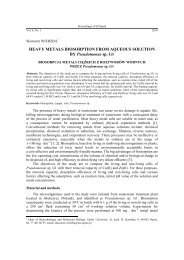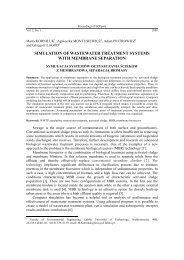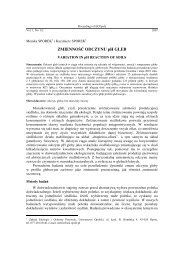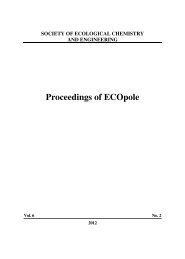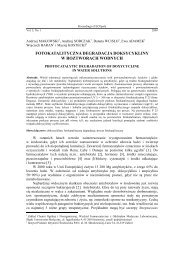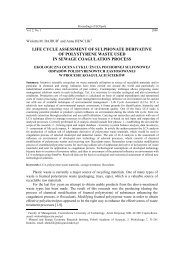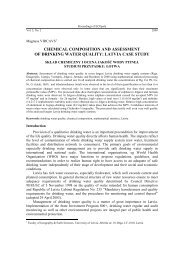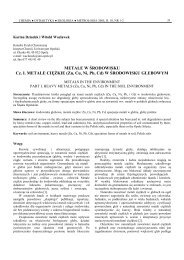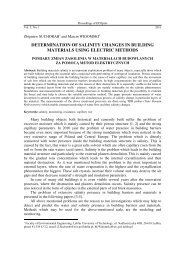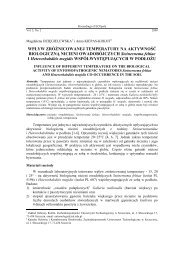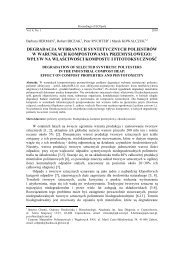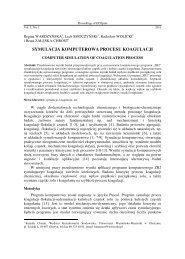DETERMINATION OF HALOACETIC ACIDS IN BEER
DETERMINATION OF HALOACETIC ACIDS IN BEER
DETERMINATION OF HALOACETIC ACIDS IN BEER
Create successful ePaper yourself
Turn your PDF publications into a flip-book with our unique Google optimized e-Paper software.
Proceedings of ECOpole<br />
Vol. 2, No. 1 2008<br />
Jiří ČULÍK 1 , Tomáš HORÁK 1 , Marie JURKOVÁ 1 , Pavel ČEJKA 1<br />
and Vladimír KELLNER 1<br />
<strong>DETERM<strong>IN</strong>ATION</strong> <strong>OF</strong> <strong>HALOACETIC</strong> <strong>ACIDS</strong> <strong>IN</strong> <strong>BEER</strong><br />
OZNACZANIE POCHODNYCH KWASU OCTOWEGO W PIWIE<br />
Summary: A method for the determination of chloroacetic acid, bromoacetic acid and iodoacetic acid in beer is<br />
described. Solid phase extraction for the sample clean-up was used. Several SPE columns were tested. Then the<br />
analytes were derivatized using BF3/methanol as methylation agent and determined by capillary gas<br />
chromatographic analysis coupled with electron capture detector. Recovery yields are nearly 100% for all<br />
monohaloacetic acids. Detection limits are lower than 0.1, 0.05 and 0.01 mg/dm 3 for chloroacetic acid,<br />
bromoacetic acid and iodoacetic acid, respectively. This procedure is suitable for routine analyses of haloacetic<br />
acids.<br />
Keywords: haloacetic acids, solid phase extraction, beer<br />
Haloacetic acids are toxic compounds which may be detected in beers after the<br />
inadequate disinfection of the technological equipment during beer production. The content<br />
of these compounds in beer is prohibited by the legislation of most countries [1].<br />
The most of published methods have been based on different extraction procedures and<br />
derivatization followed their determination by gas chromatography [2-5]. The electron<br />
capture detector respectively mass selective detector were used most frequently [2-6].<br />
Liquid-liquid extraction procedures were shown in studies [2-5]. Solid phase extraction<br />
(SPE) is another possibility for isolation of these compounds [7-9].<br />
The extracted haloacetic acids have been esterified by methylation with BF3/MeOH<br />
[7], ethylation with EtOH/SO4H2 [4, 10], buthylation with BF3/ButOH [5] or<br />
pentafluorobenzoylation with PFBBr [5, 10].<br />
In this work an improved method for the determination of haloacetic acids in beer is<br />
reported. Systematic investigations were performed on the off-line clean-up using SPE<br />
columns filled with four different types of sorbents followed derivatization of the<br />
compounds of interest with BF3/methanol derivatization agent.<br />
Experimental<br />
Reagents and standards<br />
Methanol p.a., ethanol p.a., sodium sulphite anhydrous p.a., salt acid p.a. were<br />
purchased from Lachema (Czech Republic), ethylacetate p.a., 20% solution of BF3/MetOH,<br />
hexane, chloroacetic acid, dichloroacetic acid, bromoacetic acid, iodoacetic acid were<br />
obtained from Merck (Germany). Water used was Milli-Q grade Millipore (USA).<br />
SPE columns: Extrelut (Merck, Germany), Separon SGX CN (Tessek, Czech<br />
Republic), Bond Elut SAX (Varian, USA), Separcol Si C18 (Anapron, Slovakia).<br />
1 Research Institute of Brewing and Malting, Brewing Institute Prague, Lípová 15, 120 44 Prague 2, CZ,<br />
email: horak@beerresearch.cz
16<br />
Instrumentation<br />
Jiří Čulík, Tomáš Horák, Marie Jurková, Pavel Čejka and Vladimír Kellner<br />
The GC analysis was carried out using a Carlo Erba HRGC 5300 Mega Series gas<br />
chromatograph equipped with electron capture detector. Three fused capillary columns<br />
were tested: SPB-5, 30 m x 0.32 mm i. d. with 0.25 µm film thickness; DB-1301,<br />
30 m x 0.32 mm i. d. with 0.25 µm film thickness; DB-5, 60 m x 0,32 mm i. d. with 1.0 µm<br />
film thickness.<br />
Sample preparation<br />
Prior to use SPE cartridges were conditioned by 3 cm 3 of methanol followed 3 cm 3 of<br />
purified water. Then the 20 cm 3 of sample was forced through the bed of sorbent using<br />
vacuum. The sorbent was washed with 1 cm 3 of purified water. 2 g of NaCl and 10 mm 3 of<br />
internal standard (dichloroacetic acid) were added to the collected eluate. The pH value of<br />
the sample was changed to the value 0.5 by addition of concentrated HCl and sonication<br />
was carried out for 1 min. Then the haloacetic acids were extracted with 4 x 2.5 cm 3 of<br />
ethylacetate (EtAc) by intensive shaking. After centrifugation at 3900 rpm for 4 min, the<br />
supernatant EtAc layer was transferred into flask. The EtAc solution was dried over<br />
2 g anhydrous Na2SO4. Then EtAc was removed by rotary evaporator and vacuum at 35°C.<br />
The residue was redissolved in 2 cm 3 of methanol followed by 1 cm 3 of BF3/MeOH<br />
and transferred into a screw-capped glass vial. This was cap sealed and placed for 60 min in<br />
a water bath at 85°C.<br />
After methylation, the solution was cooled and extracted with 1.5 cm 3 of hexane.<br />
Hexane layer was collected and either immediately injected into the gas chromatograph or<br />
transferred into a screw-capped glass vial and stored at –18°C for several days.<br />
Results and discussion<br />
The optimal GC conditions were evaluated. The separation of bromoacetic acid and<br />
dichloroacetic acid was not satisfied with SPB-5 column. The better results were obtained<br />
with DB 1301 column. Separation of bromoacetic acid and dichloroacetic acid was perfect<br />
but unfortunately some compound interfered with chloroacetic acid during analyses of real<br />
beer sample. The chromatogram obtained by DB-5 column, 60 m x 0.32 mm i. d. with<br />
1.0 µm film thickness gave satisfactory results. The peaks of all compounds were clearly<br />
free from interference by other GC eluents.<br />
These conditions could be recommended: the GC column was maintained at 60°C for<br />
2 min, ramped at a rate of 3°C/min to 80°C and then ramped at a rate of 40°C/min to<br />
285°C. The split-splitless injector was used and the split vent was opened after 0.5 min.<br />
Temperature of the injector and the electron capture detector were 250 and 320°C,<br />
respectively. The carrier gas was helium 5.0 quality with a column head pressure of 55 kPa<br />
at 60°C.<br />
In the second step the extraction procedure was tested. Results obtained by using<br />
sorbent Extrelut were unsatisfactory (recovery < 5%). Low recovery might be a result of<br />
degradation of sorbent at pH 0.5.<br />
SPE cartridges Separon SGX CN gave similar bad results. Cartridges filled by Bond<br />
Elut SAX produced a little bit better recoveries (about 25% for chloroacetic acid but for
Determination of haloacetic acids in beer<br />
another compounds only about 10%). Separcol Si C18 (Anapron, Slovakia) yielded the best<br />
results. So all validated experiments were done with this sorbent.<br />
The accuracy of the method was investigated by conducting the haloacetic acids<br />
recovery test. The limit of detection was obtained as 3×S/N. The repeatability of the<br />
method was investigated by repeating (five times during the same day) of the same beer<br />
sample. Results are shown in Table 1. Eight Czech beers were analyzed for haloacetic acids<br />
content. Results were negative in all cases.<br />
Limit of detection, recovery yields and RSD for haloacetic acids in beer<br />
Haloacetic acid<br />
Detection limit<br />
[mg/dm 3 ]<br />
Recovery<br />
[%]<br />
RSD<br />
[%]<br />
Chloroacetic acid 0.1 98 7<br />
Dichloroacetic acid 0.05 96 5<br />
Bromoacetic acid 0.05 96 4<br />
Iodoacetic acid 0.01 93 3<br />
Conclusions<br />
17<br />
Table 1<br />
We have demonstrated that haloacetic acids after SPE clean-up step, their extraction<br />
with ethylacetate and derivatization by BF3/MeOH can be determined in tenth respectively<br />
hundredth of mg/dm 3 in beer using gas chromatography with electron capture detector. This<br />
procedure is suitable for routine analyses of haloacetic acids in beer.<br />
Acknowledgements<br />
Authors thank members of the Czech Beer and Malt Association for financial support.<br />
This work is a part of the Research Project of the RIBM No. 6019369701.<br />
References<br />
[1] Council of the European Communities, 1987, Regulation No. 822/87.<br />
[2] Guyot A.M. and Balatre P.: Ann. Falsificat. l`expertise chimique, 1968, 61, 346-359.<br />
[3] Nijboer L.: De Ware(n)-Chemicus, 1985, 15, 18-25.<br />
[4] Fürst P., Krüger C., Habersaat K. and Groebel W.: Z. Lebensmittel Untersuch. Forsch., 1987, 185, 17-20.<br />
[5] Luckas B.: Z. Lebensmittel Untersuch. Forsch., 1987, 184, 30-32.<br />
[6] Amtliche Sammlung von Untersuchungsverfahren nach § 35 LMBG, 1989, L 36.00-10.<br />
[7] Rothenbücher L., Weishaar R. and Köbler H.: Lebensmittel Chem. Gericht. Chem., 1986, 40, 4-5.<br />
[8] Willetts P., Dennis M. J. and Massey R. C.: Food Addit. Contamin., 1991, 8, 119-124.<br />
[9] Sendra J. M. and Todo V.: J. Inst. Brew., 1990, 96, 85-87.<br />
[10] Gilsbach W.: Deutsche Lebensmittel-Rundschau, 1986, 82, 107-111.<br />
OZNACZANIE POCHODNYCH KWASU OCTOWEGO W PIWIE<br />
Streszczenie: Opisano metodę oznaczenia w piwie kwasów chlorooctowego, bromooctowego i jodooctowego. Do<br />
oczyszczania próbek wykorzystano stałą fazę ekstrakcyjną. Przetestowano kilka kolumn SPE. Anality były<br />
metylowane z wykorzystaniem układu BF3/metanol, a ich pochodne metylowe były oznaczane za pomocą<br />
kapilarnej chromatografii gazowej sprzęŜonej z detektorem wychwytu elektronów. Wydajność tego procesu jest<br />
prawie 100% dla wszystkich monohalogenowych pochodnych kwasu octowego. Granice wykrywalności dla<br />
kwasu chlorooctowego, bromooctowego i jodooctowego wynoszą kolejno mniej niŜ 0,1; 0,05 i 0,01 mg/dm 3 .<br />
Metoda ta moŜe być stosowana podczas rutynowych analiz pochodnych kwasu octowego.<br />
Słowa kluczowe: pochodne kwasu octowego, ekstrakcja fazy stałej, piwo



